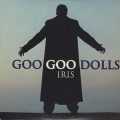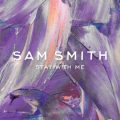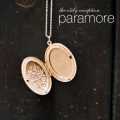I See Fire is a song recorded and produced by English singer-songwriter, Ed Sheeran. The song was commissioned for the soundtrack of the 2013 film, The Hobbit: The Desolation of Smaug, where it plays over the closing credits. The Hobbit director, Peter Jackson, asked Sheeran to write a song for the movie, after Jackson’s daughter, Katie, suggested Sheeran. Sheeran saw the film, wrote the song, and recorded most of the track elements on the same day. Today we’ll learn an easy arrangement of the I See Fire chords for acoustic guitar.
Useful links:
Song Specs
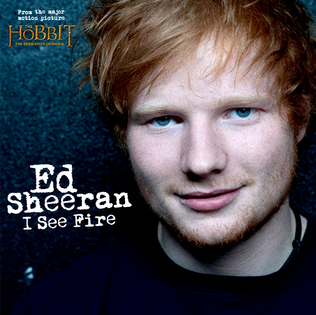 Title: I See Fire
Title: I See Fire
Artist: Ed Sheeran
Songwriters: Ed Sheeran
Album: The Hobbit: The Desolation of Smaug (Original Motion Picture Soundtrack)
Key: Em (Capo at 6th fret, actual key is Bb minor)
Tempo: 76
Chord Progression: Em–C–D–G–Am–Bm
Accompaniment Technique: Open Chords and Basic Fingerstyle
Playing Tips
Here are some helpful tips to keep in mind that will help you learn the tune faster while giving you some ideas for how to approach performing it. I provided some useful links above and I’ll take you through the I See Fire chords, accompaniment patterns, song form and a chord chart. Everything you need to get started playing this tune.
I See Fire Chords
| Chords | Em | G | Am | Bm | C | D |
| Progression | i | bIII | iv | v | bVI | bVII |

I See Fire is the key of Bb minor major. However, if we add a capo to the 6th fret, we can use chords in the key of E minor. We’ll be playing in the key of Bb minor but thinking in the key of E minor—a much more guitar-friendly key.
The song begins with a haunting melody sung a cappella and rubato (which means voice only and freely or without a specific beat). This sets the minor-key mood and then begins with an E minor pentatonic fill that launches the Em–C–D chord riff.
This is a fun and easy tune that you can quickly add to your repertoire. It’s also a great tune for those venturing into the world of fingerstyle playing and singing while playing. The repetitive nature of the chord progression and accompaniment pattern lend themselves to working on these skills.
Accompaniment Techniques
I suggest using a combination of fingerplucking, fingerstrumming and sporadic percussive strums for playing this tune.
- The fingerplucking technique is a simpler version of fingerstyle as all of the fingers pluck the strings at the same time.
- The fingerstrumming technique uses the index and middle fingers for downstrums and the index only for upstrums.
- The percussive strum technique is a right-hand technique that’s described below and in the video in more detail.
- The fingerstyle technique is used slightly as a thumb (bass) to fingers (chord) pattern that can add interest.
Basic Fingerstyle Technique
I See Fire is perfect for beginning fingerstyle players. The right hand is notated as follows:
- P = Thumb
- I = Index
- M = Middle
- A = Ring
I find that using a pick to strum the I See Fire chords can be a little too harsh sounding for the mood of this tune. For that reason, I suggest using your fingers to pluck and strum the chords. Let’s begin by assigning the right-hand fingers to certain strings:
- The Thumb (P) plays the bass note on the 5th and 6th strings (depending on the chord, of course).
- The Index (I) is assigned to the 4th string.
- The Middle (M) is assigned to the 3rd string.
- The Ring (A) is assigned to the 2nd string.
This is the essence of fingerstyle playing, assigning fingers to specific strings. This way, you don’t need to look at the right hand while playing. Once you get used to it, you can “feel” where you are.
I suggest using the finger-plucking technique for the verse and the finger-strumming technique for the prechorus. I explain this in more detail in the video.
Percussive Strum
This technique is subtle but adds to the groove and feel of the tune. Here’s how to execute it:
- Use the same finger assignments as described above.
- Finger-pluck the chord on Beat 1.
- On Beat 2, bring the fingers back to their assigned strings creating a muted strum.
- Finger-pluck the next chord on the “and of Beat 2”.
- On Beat 4, bring the fingers back to their assigned strings creating a muted strum.
Chord Chart
I’ve included a chord chart, which is a simple road map that shows you:
- The overall arrangement of the song.
- A section by section breakdown of the song.
- Each chord and how long to play it for.
If you don’t read music, please don’t be intimidated. This is a cheat sheet that can help you get through the tune quickly and easily. I find it indispensable for learning songs and I can also hand it to a seasoned musician and they can follow along without any problems.
Song Form
- Intro/Main Riff: A 4-measure section; the two measure Em–C–D–Em chord riff is played twice.
- Verse: An 8-measure section that is made up of (4) two-bar chord patterns; Pattern 1 is Em–G–D–C, Pattern 2 is Em–G–D–Am, Pattern 3 is exactly the same as Pattern 1 and Pattern 4 is Am–Bm–C.
- Main Riff/Segue: A 2-measure section; the Em–C–D–Em chord riff is played once.
- Chorus: A 9-measure section; Again we see a two-bar pattern, Em–C–D–Em from the Main Riff section. This pattern is repeated 4 times and the final time we end on an Am instead of the Em and we hold it for an extra measure.
Once you become familiar with chord charts, you’ll never want to go back. It’s just easier to see where you’re going when you have a map. And, it’s especially helpful when you’re not familiar with the song or there’s a section of the song that you don’t remember (Bridges and Interludes are notorious for surprising players and derailing a song’s performance). Fortunately, this tune has neither a Bridge or Interlude.
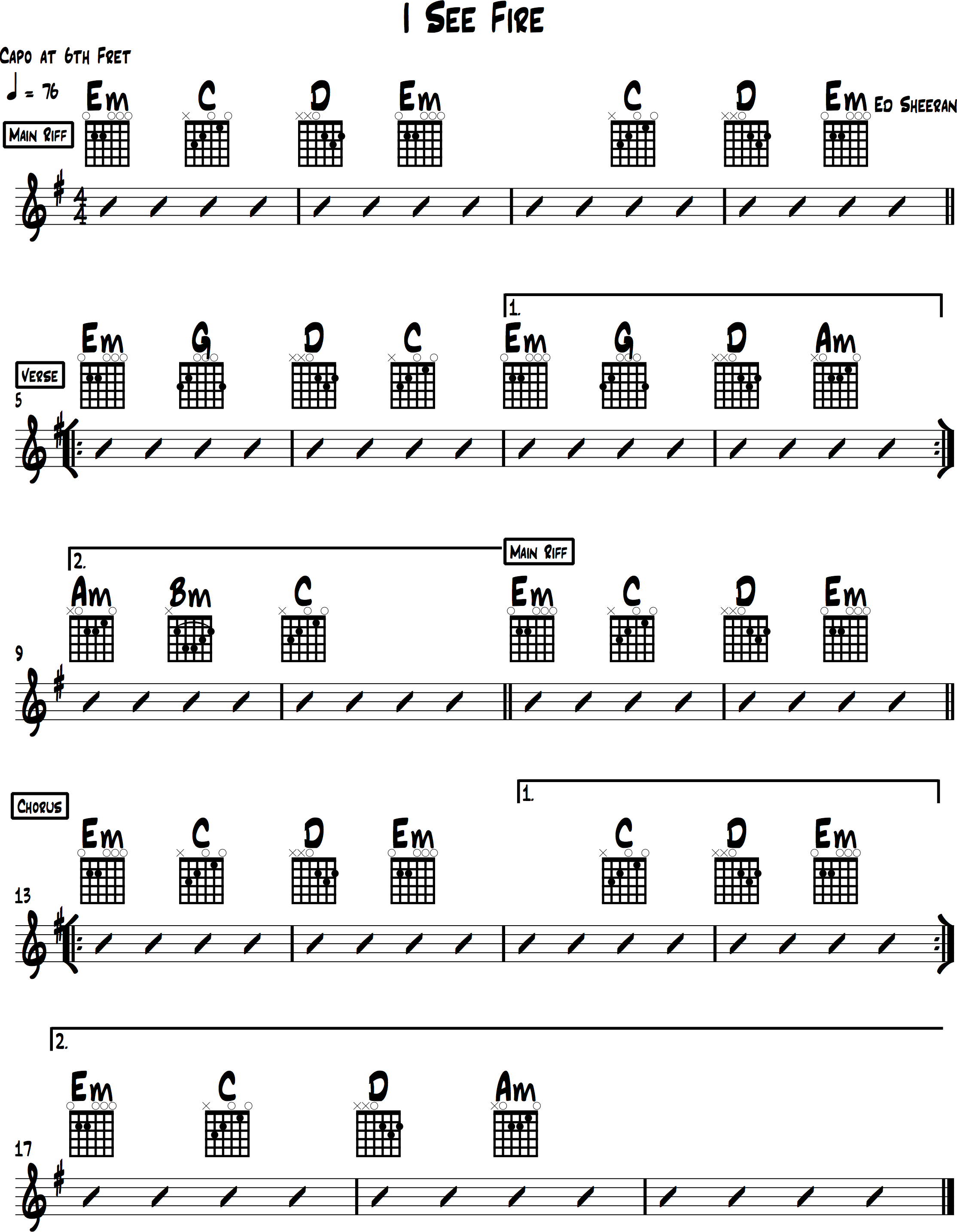
Wrap-up
I hope that you’ve enjoy learning the I See Fire chords! This is a beautiful tune that turns heads as most audience members recognize it but aren’t expecting to hear it.
I appreciate you checking out this lesson. Thank you for hanging with me and I’ll see you next time.




